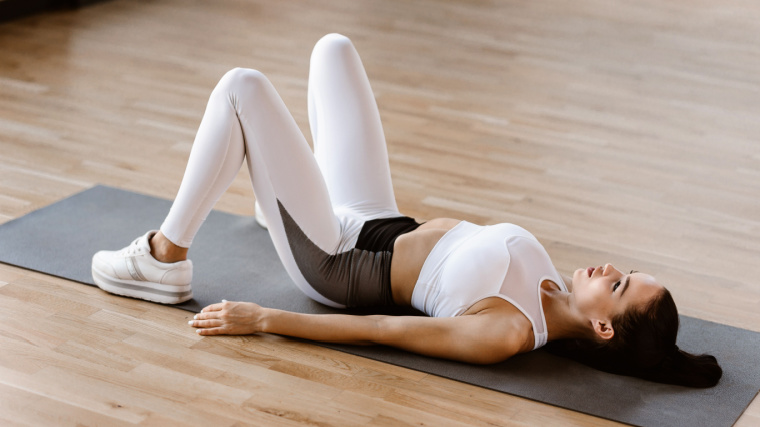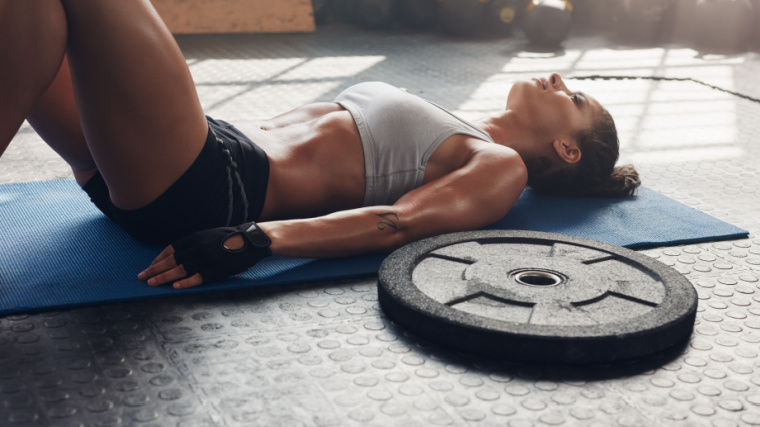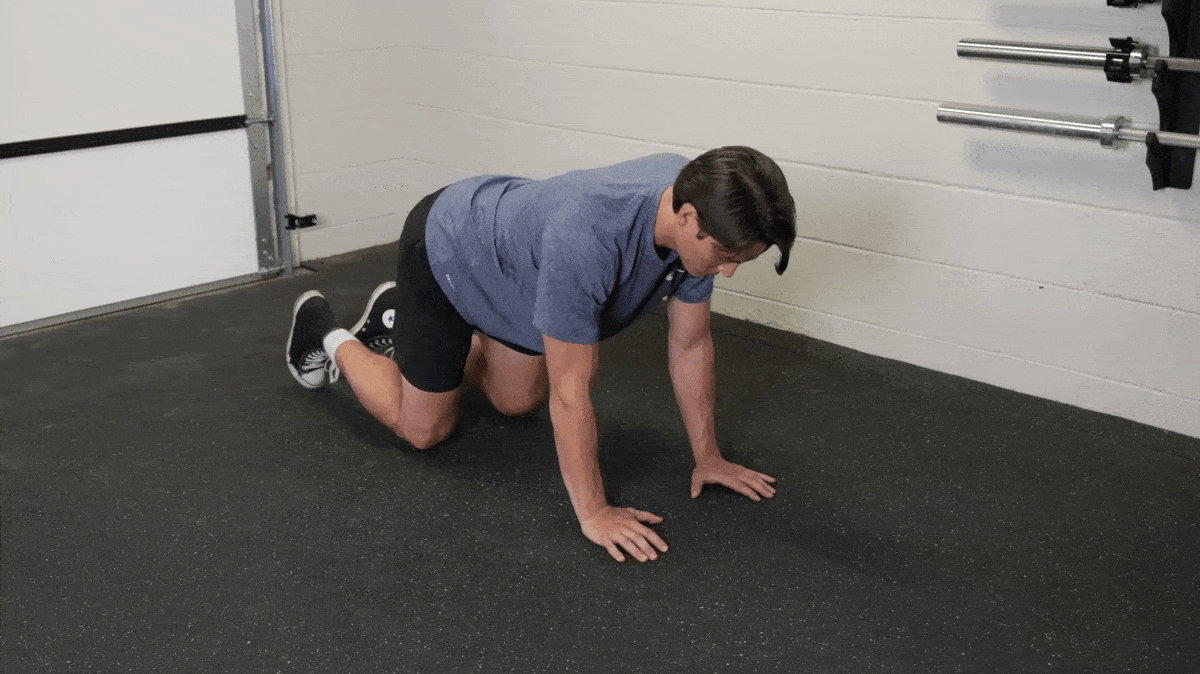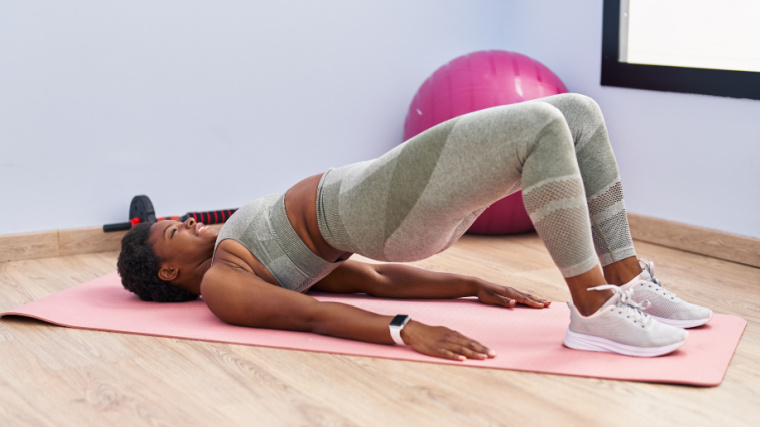Muscle Insider
New member
Pelvic tilts are often an underrated move in the gym despite being a favorite of many physical therapists. They help to strengthen the core muscles, which are active in pretty much everything you ... Read more
The post How to Do Pelvic Tilts for Better Core Strength and Control appeared first on BarBend.
Pelvic tilts are often an underrated move in the gym despite being a favorite of many physical therapists. They help to strengthen the core muscles, which are active in pretty much everything you do. This includes everything from explosive snatches and 500-pound deadlifts to squatting down to pick up a laundry basket.
You don’t need any equipment or a load of lifting experience to pull off one of the best exercises you can do for your abs, hips, and lower back. But you will have to be mindful of your form. Even the best ab exercises require intentional movements and attentiveness to your body. Your focus is sure to pay off in the weight room and your home gym.
 Credit: Dmytro Sheremeta / Shutterstock
Credit: Dmytro Sheremeta / Shutterstock
The pelvic tilt might seem humble, but it can help take some strain off your lower back, increase strength in your core, and boost your overall lifting performance. Here’s everything you need to know about the pelvic tilt.
How to Do Pelvic Tilts
Pelvic tilts can be done anywhere, and most variations don’t need any equipment at all. This is one of the reasons this versatile exercise is a staple in many at-home workout programs — but it transfers just as well to a gym setting.
Just bring yourself, and it’ll be time to get started.
Step 1 — Set Up
 Credit: Leika production / Shutterstock
Credit: Leika production / Shutterstock
Lie on your back on a firm but comfortable surface, like an exercise mat or yoga mat. If you’re doing this at home and getting down onto the floor isn’t something you’re comfortable with, a firm bed works just as well. Choose your location, and get settled lying flat on your back.
Bend both of your knees, so that the soles of your feet are flat on the floor. This creates a neutral position for your spine so that your lower back lifts slightly off the floor.
Coach’s Tip: Adjust the position of your feet as needed to help ensure a stable starting position.
Step 2 — Rock Your Hips
 Credit: Jacob Lund / Shutterstock
Credit: Jacob Lund / Shutterstock
On an exhale, gently press your hips up. You’ll be tilting your tailbone up and closing any gap between your lower back and the floor.
Coach’s Tip: Make sure you’re engaging your abdominal muscles to produce this small, subtle motion. Avoid using momentum from your legs.
Step 3 — Hold This Position
 Credit: Jacob Lund / Shutterstock
Credit: Jacob Lund / Shutterstock
Stay here, and take a couple of deep belly breaths. When you’re ready, relax your abdominal muscles to let your lower back return to its neutral position.
Coach’s Tip: You may not be able to hold this position for long at first. Aim to work up to holding each rep for 10 to 15 seconds before lowering with control.
Pelvic Tilt Variations
The pelvic tilt is a versatile movement. You can perform it lying down, standing, on all fours, and in a range of other ways. Here, you’ll find a handpicked selection of pelvic tilt variations. If you’re pregnant or unable to lie on your back, the standing version of this movement may be more comfortable for you.
Standing Pelvic Tilts
[Read More: Build a Titanic Torso with These Bodybuilding Chest & Back Workouts]
[*]Stand with your back against a wall and slightly lean toward it.
[*]Breathe in and allow your knees to bend slightly.
[*]Breathe out as you lift your hips up away from the wall and toward your face. Aim to press your lower back against the wall.
[*]When you’re ready, breathe in and return to your lower back’s neutral position.
Kneeling Pelvic Tilts
[Read More: How to Do the Lat Pulldown for a Wider Back and Better Pull-Ups]
[*]Kneel on a padded surface with your wrists under your shoulders and your knees aligned under your hips.
[*]Inhale, then breathe out and pull upward with your abdominal muscles. Simultaneously round your back and press into your hands.
[*]Slowly release and return to a neutral position.
Seated Pelvic Tilts on an Exercise Ball
[Read More: The Best Back Workout for Men, Women, Strength, and More]
[*]Choose an exercise ball of the right size — try to have your hips slightly higher than your knees.
[*]Breathe out and tuck your tailbone under you so you roll forward slightly on the ball.
[*]Breathe in and press your tailbone back, rolling the ball away from your feet and back to a neutral position.
Pelvic Tilt Alternatives
If you’re not quite able to do a pelvic tilt, don’t worry — it’s not the only option for you. And if you’re searching for other ways to fire up your core and build your control and stability, these alternatives have got you covered, too.
Glute Bridge
[Read More: How to Do the Goblet Squat — Variations, Benefits, Mistakes, and More]
[*]Lie on your back.
[*]Bend your knees and extend your arms out beside your body.
[*]Engage your core muscles by pushing your lower back into the ground.
[*]Raise your hips to make a straight line from your knees to your shoulders.
[*]Squeeze your core muscles and pull your belly button back toward your spine.
Bird Dog

[Read More: What Are Workout Splits and Which Is the Best One?]
[*]Kneel on a mat on your hands and knees, with your knees under your hips and your hands under your shoulders.
[*]Straighten one arm and extend the opposite leg out behind you. Keep your lower back straight and your hips squared to the ground.
[*]Hold for a few seconds, then return to your hands and knees, keeping your core engaged throughout.
[*]Switch to the other side.
Plank
[Read More: Romanian Deadlift Vs. Deadlift — Which is Better for Your Program?]
[*]Begin face down with your forearms and toes on a mat.* Aim to have your elbows under your shoulders, your forearms facing forward, and keep your gaze toward the floor.
[*]Engage your core muscles by drawing your belly button toward your spine and pulling inward from all angles in your torso. Squeeze your quads and glutes.
[*]Hold this position — start with five seconds and build up. Make sure to breathe deeply through your belly throughout the hold.
*Too hard? Stay on your knees throughout the plank instead of your toes.
Benefits of the Pelvic Tilt
Pelvic tilts have a whole host of benefits. Alongside strengthening your deep core muscles, they also help to stretch tight muscles in the lower back.
For some people, the pelvic tilt can be a great exercise to address lower back pain. Here, we’ll dive into the reasons why.
Stronger Core
Pelvic tilts start to gently strengthen your core muscles. A stronger, more stable core leads to better performance in the gym, particularly with compound exercises that require a strong brace to keep your torso aligned and your back neutral. Think bent-over rows, deadlifts, and all manner of squat variations.
In addition, having strong core muscles helps day-to-day tasks feel less demanding, like gardening or cleaning the house. This is because when you have strong core muscles, it’s easier to move more efficiently across your entire body.
Stretch Your Lower Back
Many people have tight muscles in their lower back, which can lead to a general feeling of stiffness or achiness. If you have an office job or otherwise sit for long periods each day, you might be well-acquainted with this sensation.
 Credit: Krakenimages.com / Shutterstock
Credit: Krakenimages.com / Shutterstock
The good news is that pelvic tilts can help to stretch these muscles. So you may find that your lower back becomes less stiff after the stretching it receives from pelvic tilts.
Combat Lower Back Pain
Some people stand and move with their pelvis tilted slightly forward. This is known as anterior pelvic tilt. While an anterior pelvic tilt is a natural body stance for many, people with a very exaggerated tilt — or athletes who don’t adjust the tilt to accommodate weight on the bar — may experience lower back pain. The pelvic tilt exercise can help to correct this.
The combination of strengthening the core and stretching tight muscles in your lower back can lead to better posture and less back pain. (1)
Muscles Worked by the Pelvic Tilt
When you think of the core, do you think of the “ab” muscles? You’re not alone. Your core muscles include the abdominal, pelvic floor, diaphragm, and spinal muscles. Pelvic tilt exercises strengthen two areas of the core in particular.
Multifidus
This is part of your deep intrinsic back muscles — it helps you to extend and rotate your spine.
Transverse Abdominis
This muscle is the deepest of the abdominal muscles. It’s a stabilizing muscle that extends between your pelvis and your ribs, wrapping around your spine.
Who Should Do the Pelvic Tilt
Athletes who are trying to build their core strength shouldn’t dismiss the pelvic tilt just because it might appear “easy.” It packs a punch, and within that punch are a whole lot of benefits. Here are some types of athletes that may want to give it a try.
Beginners
The joy of the pelvic tilt exercise is that it can be done pretty much anywhere, by anyone. No equipment? No problem. Can’t lie flat? You can stand against a wall or sit on an exercise stability ball or even a chair instead.
Whether you’re warming up for a gym session or getting in a five-minute home workout on your lunch break, the pelvic tilt makes a great addition to your workout routine. No gym experience required.
Strength Athletes and Powerlifters
It’s common knowledge that a strong core is key to strong lifts. “Engage your core” is a phrase batted around gyms by personal trainers across the strength sports spectrum. But what if you struggle to engage yours? Or what if your core’s not strong enough once engaged?
 Credit: Monstar Studio / Shutterstock
Credit: Monstar Studio / Shutterstock
The pelvic tilt has got your back. If consciously engaging your core is something you struggle with, the pelvic tilt could be the perfect exercise for you.
Pelvic Tilt Sets and Reps
How you train pelvic tilts will determine which benefits you’ll reap from them. Here are a couple of ways you can train depending on your goals.
Common Pelvic Tilt Mistakes
Although it’s a beginner core exercise, there are still plenty of ways a pelvic tilt can go wrong. Breath-holding, questionable core engagement, and overzealous movement are the top culprits.
Not Engaging Your Core
Despite your best intentions, you’re not engaging your core correctly if you stick out your stomach or in your belly without activating the right muscles.
[Read More: The Ultimate 10-Week Powerbuilding Workout Routine for Mass and Strength]
The trick to engaging your core is to brace yourself for a sucker punch to the stomach — take a deep breath and imagine you’re “zipping up” your abs. This means drawing your belly button up and toward your spine. You’ll also want to contract from all 360 degrees, where your sides are also tensing. Treat your abs like they’re three-dimensional because they are.
Holding Your Breath
Holding your breath may make it feel easier to engage your core muscles, but in reality, it’s not a helpful way to train. You’ll tire fast during your pelvic tilts as you start to run out of air. Breathing deeply during your pelvic tilts can also help you feel your ab muscles even more, enhancing your engagement.
Rolling Your Hips in the Wrong Direction
It can be easy to get confused and roll your hips the wrong way, arching your back so that it lifts off the floor. Instead, aim to push your lower back into the ground and try to get it to lie smoothly against the mat.
Master Your Core, Master Your Lifts
Your core is undeniably at the center of your training. If your center is working as it’s meant to, everything else tends to fall into place. Throwing a few pelvic tilts into your training routine is a great place to start.
This move is versatile, as it can be done anywhere, by a wide range of athletes. Pelvic tilts offer a solid launch pad for more intensive core exercises, and it’s a powerful exercise in its own right. Grab your yoga mat, take a deep breath, and give it a try.
FAQs
Still haven’t found the answer you’re looking for? Here are a few of the questions that are asked about this exercise most often.
Where do pelvic tilts fit in my workout? Pelvic tilts make a dynamic warm-up move before heavier lifts, particularly barbell exercises that recruit your core a lot, like front squats and deadlifts. This is because they mobilize your back and activate your core muscles without tiring you out too much, so you’re primed to lift.
Alternatively, if you have a specific core strengthening section of your workout or if you do any of your workouts from home, pelvic tilts would fit nicely in there.
Do the variations work as well as lying flat?If you’re pregnant or unable to lie on your back for any other reason, have no fear. There’s a pelvic tilt variation for so many people. There are standing, kneeling, and sitting options available for this move. These work just as well as the lying-flat version, as long as you can get the hang of the technique.
Will pelvic tilts help my back pain?It depends on what the cause of your back pain is. If you have back pain, it’s always best to get it assessed by a physical therapist or other medical professional. However, research does suggest that core stabilizing exercises (such as pelvic tilts) may be able to reduce lower back pain. (1)
{"@context":"https://schema.org","@type":"FAQPage","mainEntity":[{"@type":"Question","name":"Where do pelvic tilts fit in my workout? ","acceptedAnswer":{"@type":"Answer","text":"Pelvic tilts make a dynamic warm-up move before heavier lifts, particularly barbell exercises that recruit your core a lot, like front squats and deadlifts. This is because they mobilize your back and activate your core muscles without tiring you out too much, so youu2019re primed to lift.
nAlternatively, if you have a specific core strengthening section of your workout or if you do any of your workouts from home, pelvic tilts would fit nicely in there.
n"}},{"@type":"Question","name":"Do the variations work as well as lying flat?","acceptedAnswer":{"@type":"Answer","text":"If youu2019re pregnant or unable to lie on your back for any other reason, have no fear. Thereu2019s a pelvic tilt variation for so many people. There are standing, kneeling, and sitting options available for this move. These work just as well as the lying-flat version, as long as you canu00a0get the hang of the technique.
n"}},{"@type":"Question","name":"Will pelvic tilts help my back pain?","acceptedAnswer":{"@type":"Answer","text":"It depends on what the cause of your back pain is. If you have back pain, itu2019s always best to get it assessed by a physical therapist or other medical professional. However, research does suggest that core stabilizing exercises (such as pelvic tilts) may be able to reduce lower back pain. (1)
n"}}]}
References
[*]Coulombe, B. J., Games, K. E., Neil, E. R., & Eberman, L. E. (2017). Core Stability Exercise Versus General Exercise for Chronic Low Back Pain. Journal of Athletic Training, 52(1), 71–72.
Featured Image: Dmytro Sheremeta / Shutterstock
The post How to Do Pelvic Tilts for Better Core Strength and Control appeared first on BarBend.
Click here to view the article.
The post How to Do Pelvic Tilts for Better Core Strength and Control appeared first on BarBend.
Pelvic tilts are often an underrated move in the gym despite being a favorite of many physical therapists. They help to strengthen the core muscles, which are active in pretty much everything you do. This includes everything from explosive snatches and 500-pound deadlifts to squatting down to pick up a laundry basket.
You don’t need any equipment or a load of lifting experience to pull off one of the best exercises you can do for your abs, hips, and lower back. But you will have to be mindful of your form. Even the best ab exercises require intentional movements and attentiveness to your body. Your focus is sure to pay off in the weight room and your home gym.
 Credit: Dmytro Sheremeta / Shutterstock
Credit: Dmytro Sheremeta / ShutterstockThe pelvic tilt might seem humble, but it can help take some strain off your lower back, increase strength in your core, and boost your overall lifting performance. Here’s everything you need to know about the pelvic tilt.
- How to Do the Pelvic Tilt
- Pelvic Tilt Variations
- Pelvic Tilt Alternatives
- Benefits of the Pelvic Tilt
- Muscles Worked by the Pelvic Tilt
- Who Should Do the Pelvic Tilt
- Pelvic Tilt Sets and Reps
- Common Pelvic Tilt Mistakes
- Frequently Asked Questions
How to Do Pelvic Tilts
Pelvic tilts can be done anywhere, and most variations don’t need any equipment at all. This is one of the reasons this versatile exercise is a staple in many at-home workout programs — but it transfers just as well to a gym setting.
Just bring yourself, and it’ll be time to get started.
Step 1 — Set Up
 Credit: Leika production / Shutterstock
Credit: Leika production / ShutterstockLie on your back on a firm but comfortable surface, like an exercise mat or yoga mat. If you’re doing this at home and getting down onto the floor isn’t something you’re comfortable with, a firm bed works just as well. Choose your location, and get settled lying flat on your back.
Bend both of your knees, so that the soles of your feet are flat on the floor. This creates a neutral position for your spine so that your lower back lifts slightly off the floor.
Coach’s Tip: Adjust the position of your feet as needed to help ensure a stable starting position.
Step 2 — Rock Your Hips
 Credit: Jacob Lund / Shutterstock
Credit: Jacob Lund / ShutterstockOn an exhale, gently press your hips up. You’ll be tilting your tailbone up and closing any gap between your lower back and the floor.
Coach’s Tip: Make sure you’re engaging your abdominal muscles to produce this small, subtle motion. Avoid using momentum from your legs.
Step 3 — Hold This Position
 Credit: Jacob Lund / Shutterstock
Credit: Jacob Lund / ShutterstockStay here, and take a couple of deep belly breaths. When you’re ready, relax your abdominal muscles to let your lower back return to its neutral position.
Coach’s Tip: You may not be able to hold this position for long at first. Aim to work up to holding each rep for 10 to 15 seconds before lowering with control.
Pelvic Tilt Variations
The pelvic tilt is a versatile movement. You can perform it lying down, standing, on all fours, and in a range of other ways. Here, you’ll find a handpicked selection of pelvic tilt variations. If you’re pregnant or unable to lie on your back, the standing version of this movement may be more comfortable for you.
Standing Pelvic Tilts
[Read More: Build a Titanic Torso with These Bodybuilding Chest & Back Workouts]
[*]Stand with your back against a wall and slightly lean toward it.
[*]Breathe in and allow your knees to bend slightly.
[*]Breathe out as you lift your hips up away from the wall and toward your face. Aim to press your lower back against the wall.
[*]When you’re ready, breathe in and return to your lower back’s neutral position.
Kneeling Pelvic Tilts
[Read More: How to Do the Lat Pulldown for a Wider Back and Better Pull-Ups]
[*]Kneel on a padded surface with your wrists under your shoulders and your knees aligned under your hips.
[*]Inhale, then breathe out and pull upward with your abdominal muscles. Simultaneously round your back and press into your hands.
[*]Slowly release and return to a neutral position.
Seated Pelvic Tilts on an Exercise Ball
[Read More: The Best Back Workout for Men, Women, Strength, and More]
[*]Choose an exercise ball of the right size — try to have your hips slightly higher than your knees.
[*]Breathe out and tuck your tailbone under you so you roll forward slightly on the ball.
[*]Breathe in and press your tailbone back, rolling the ball away from your feet and back to a neutral position.
Pelvic Tilt Alternatives
If you’re not quite able to do a pelvic tilt, don’t worry — it’s not the only option for you. And if you’re searching for other ways to fire up your core and build your control and stability, these alternatives have got you covered, too.
Glute Bridge
[Read More: How to Do the Goblet Squat — Variations, Benefits, Mistakes, and More]
[*]Lie on your back.
[*]Bend your knees and extend your arms out beside your body.
[*]Engage your core muscles by pushing your lower back into the ground.
[*]Raise your hips to make a straight line from your knees to your shoulders.
[*]Squeeze your core muscles and pull your belly button back toward your spine.
Bird Dog

[Read More: What Are Workout Splits and Which Is the Best One?]
[*]Kneel on a mat on your hands and knees, with your knees under your hips and your hands under your shoulders.
[*]Straighten one arm and extend the opposite leg out behind you. Keep your lower back straight and your hips squared to the ground.
[*]Hold for a few seconds, then return to your hands and knees, keeping your core engaged throughout.
[*]Switch to the other side.
Plank
[Read More: Romanian Deadlift Vs. Deadlift — Which is Better for Your Program?]
[*]Begin face down with your forearms and toes on a mat.* Aim to have your elbows under your shoulders, your forearms facing forward, and keep your gaze toward the floor.
[*]Engage your core muscles by drawing your belly button toward your spine and pulling inward from all angles in your torso. Squeeze your quads and glutes.
[*]Hold this position — start with five seconds and build up. Make sure to breathe deeply through your belly throughout the hold.
*Too hard? Stay on your knees throughout the plank instead of your toes.
Benefits of the Pelvic Tilt
Pelvic tilts have a whole host of benefits. Alongside strengthening your deep core muscles, they also help to stretch tight muscles in the lower back.
For some people, the pelvic tilt can be a great exercise to address lower back pain. Here, we’ll dive into the reasons why.
Stronger Core
Pelvic tilts start to gently strengthen your core muscles. A stronger, more stable core leads to better performance in the gym, particularly with compound exercises that require a strong brace to keep your torso aligned and your back neutral. Think bent-over rows, deadlifts, and all manner of squat variations.
In addition, having strong core muscles helps day-to-day tasks feel less demanding, like gardening or cleaning the house. This is because when you have strong core muscles, it’s easier to move more efficiently across your entire body.
Stretch Your Lower Back
Many people have tight muscles in their lower back, which can lead to a general feeling of stiffness or achiness. If you have an office job or otherwise sit for long periods each day, you might be well-acquainted with this sensation.
 Credit: Krakenimages.com / Shutterstock
Credit: Krakenimages.com / ShutterstockThe good news is that pelvic tilts can help to stretch these muscles. So you may find that your lower back becomes less stiff after the stretching it receives from pelvic tilts.
Combat Lower Back Pain
Some people stand and move with their pelvis tilted slightly forward. This is known as anterior pelvic tilt. While an anterior pelvic tilt is a natural body stance for many, people with a very exaggerated tilt — or athletes who don’t adjust the tilt to accommodate weight on the bar — may experience lower back pain. The pelvic tilt exercise can help to correct this.
The combination of strengthening the core and stretching tight muscles in your lower back can lead to better posture and less back pain. (1)
Muscles Worked by the Pelvic Tilt
When you think of the core, do you think of the “ab” muscles? You’re not alone. Your core muscles include the abdominal, pelvic floor, diaphragm, and spinal muscles. Pelvic tilt exercises strengthen two areas of the core in particular.
Multifidus
This is part of your deep intrinsic back muscles — it helps you to extend and rotate your spine.
Transverse Abdominis
This muscle is the deepest of the abdominal muscles. It’s a stabilizing muscle that extends between your pelvis and your ribs, wrapping around your spine.
Who Should Do the Pelvic Tilt
Athletes who are trying to build their core strength shouldn’t dismiss the pelvic tilt just because it might appear “easy.” It packs a punch, and within that punch are a whole lot of benefits. Here are some types of athletes that may want to give it a try.
Beginners
The joy of the pelvic tilt exercise is that it can be done pretty much anywhere, by anyone. No equipment? No problem. Can’t lie flat? You can stand against a wall or sit on an exercise stability ball or even a chair instead.
Whether you’re warming up for a gym session or getting in a five-minute home workout on your lunch break, the pelvic tilt makes a great addition to your workout routine. No gym experience required.
Strength Athletes and Powerlifters
It’s common knowledge that a strong core is key to strong lifts. “Engage your core” is a phrase batted around gyms by personal trainers across the strength sports spectrum. But what if you struggle to engage yours? Or what if your core’s not strong enough once engaged?
 Credit: Monstar Studio / Shutterstock
Credit: Monstar Studio / ShutterstockThe pelvic tilt has got your back. If consciously engaging your core is something you struggle with, the pelvic tilt could be the perfect exercise for you.
Pelvic Tilt Sets and Reps
How you train pelvic tilts will determine which benefits you’ll reap from them. Here are a couple of ways you can train depending on your goals.
- For Core Strength: As a strengthening exercise, three sets of five is an excellent starting point. These are best performed slowly, with a focus on technique and a firm hold rather than power. Even five reps should take about a minute, given that each rep can include a 10-second hold.
- For Endurance: To work on endurance, do three to four sets of 10 repetitions, resting for around one to two minutes between your sets.
- For Technique: If your focus is forming a better mind-muscle connection with your core, try doing one set of three to five reps before each set of your main lift of the day.
Common Pelvic Tilt Mistakes
Although it’s a beginner core exercise, there are still plenty of ways a pelvic tilt can go wrong. Breath-holding, questionable core engagement, and overzealous movement are the top culprits.
Not Engaging Your Core
Despite your best intentions, you’re not engaging your core correctly if you stick out your stomach or in your belly without activating the right muscles.
[Read More: The Ultimate 10-Week Powerbuilding Workout Routine for Mass and Strength]
The trick to engaging your core is to brace yourself for a sucker punch to the stomach — take a deep breath and imagine you’re “zipping up” your abs. This means drawing your belly button up and toward your spine. You’ll also want to contract from all 360 degrees, where your sides are also tensing. Treat your abs like they’re three-dimensional because they are.
Holding Your Breath
Holding your breath may make it feel easier to engage your core muscles, but in reality, it’s not a helpful way to train. You’ll tire fast during your pelvic tilts as you start to run out of air. Breathing deeply during your pelvic tilts can also help you feel your ab muscles even more, enhancing your engagement.
Rolling Your Hips in the Wrong Direction
It can be easy to get confused and roll your hips the wrong way, arching your back so that it lifts off the floor. Instead, aim to push your lower back into the ground and try to get it to lie smoothly against the mat.
Master Your Core, Master Your Lifts
Your core is undeniably at the center of your training. If your center is working as it’s meant to, everything else tends to fall into place. Throwing a few pelvic tilts into your training routine is a great place to start.
This move is versatile, as it can be done anywhere, by a wide range of athletes. Pelvic tilts offer a solid launch pad for more intensive core exercises, and it’s a powerful exercise in its own right. Grab your yoga mat, take a deep breath, and give it a try.
FAQs
Still haven’t found the answer you’re looking for? Here are a few of the questions that are asked about this exercise most often.
Where do pelvic tilts fit in my workout? Pelvic tilts make a dynamic warm-up move before heavier lifts, particularly barbell exercises that recruit your core a lot, like front squats and deadlifts. This is because they mobilize your back and activate your core muscles without tiring you out too much, so you’re primed to lift.
Alternatively, if you have a specific core strengthening section of your workout or if you do any of your workouts from home, pelvic tilts would fit nicely in there.
Do the variations work as well as lying flat?If you’re pregnant or unable to lie on your back for any other reason, have no fear. There’s a pelvic tilt variation for so many people. There are standing, kneeling, and sitting options available for this move. These work just as well as the lying-flat version, as long as you can get the hang of the technique.
Will pelvic tilts help my back pain?It depends on what the cause of your back pain is. If you have back pain, it’s always best to get it assessed by a physical therapist or other medical professional. However, research does suggest that core stabilizing exercises (such as pelvic tilts) may be able to reduce lower back pain. (1)
{"@context":"https://schema.org","@type":"FAQPage","mainEntity":[{"@type":"Question","name":"Where do pelvic tilts fit in my workout? ","acceptedAnswer":{"@type":"Answer","text":"Pelvic tilts make a dynamic warm-up move before heavier lifts, particularly barbell exercises that recruit your core a lot, like front squats and deadlifts. This is because they mobilize your back and activate your core muscles without tiring you out too much, so youu2019re primed to lift.
nAlternatively, if you have a specific core strengthening section of your workout or if you do any of your workouts from home, pelvic tilts would fit nicely in there.
n"}},{"@type":"Question","name":"Do the variations work as well as lying flat?","acceptedAnswer":{"@type":"Answer","text":"If youu2019re pregnant or unable to lie on your back for any other reason, have no fear. Thereu2019s a pelvic tilt variation for so many people. There are standing, kneeling, and sitting options available for this move. These work just as well as the lying-flat version, as long as you canu00a0get the hang of the technique.
n"}},{"@type":"Question","name":"Will pelvic tilts help my back pain?","acceptedAnswer":{"@type":"Answer","text":"It depends on what the cause of your back pain is. If you have back pain, itu2019s always best to get it assessed by a physical therapist or other medical professional. However, research does suggest that core stabilizing exercises (such as pelvic tilts) may be able to reduce lower back pain. (1)
n"}}]}
References
[*]Coulombe, B. J., Games, K. E., Neil, E. R., & Eberman, L. E. (2017). Core Stability Exercise Versus General Exercise for Chronic Low Back Pain. Journal of Athletic Training, 52(1), 71–72.
Featured Image: Dmytro Sheremeta / Shutterstock
The post How to Do Pelvic Tilts for Better Core Strength and Control appeared first on BarBend.
Click here to view the article.

